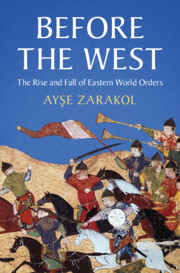Book contents
- Before the West
- LSE International Studies
- Before the West
- Copyright page
- Dedication
- Contents
- Figures and Maps
- Acknowledgements
- Maps
- 1 What Is the East?
- Part I Cihannüma
- 2 Making the East: Chinggisid World Orders
- 3 Dividing the East: Post-Chinggisid World Orders
- 4 Expanding the East: Post-Timurid World Orders
- 5 How the East Made the World: Eurasia and Beyond
- Part II Lessons of History
- Bibliography
- Index
2 - Making the East: Chinggisid World Orders
The Empire of Genghis Khan and Its Successor Khanates (Thirteenth–Fourteenth Centuries)
from Part I - Cihannüma
Published online by Cambridge University Press: 24 February 2022
- Before the West
- LSE International Studies
- Before the West
- Copyright page
- Dedication
- Contents
- Figures and Maps
- Acknowledgements
- Maps
- 1 What Is the East?
- Part I Cihannüma
- 2 Making the East: Chinggisid World Orders
- 3 Dividing the East: Post-Chinggisid World Orders
- 4 Expanding the East: Post-Timurid World Orders
- 5 How the East Made the World: Eurasia and Beyond
- Part II Lessons of History
- Bibliography
- Index
Summary
This chapter argues that the empire of Genghis Khan made 'Asia' and/or 'the East'. Genghis Khan not only politically unified most of Asia in the thirteenth century but also changed the conception of sovereignty throughout the continent by disseminating, through his own example, the norm of the political ruler as the exclusive supreme authority, legitimised by world domination. This chapter gives an overview of the rise and decline of the Chinggisid world order (as constructed by the Mongol world empire and later maintained by the successor khanates: Yuan, Chaggataid, Ilkhanate, Jochid/Golden Horde). At its peak this world order covered most of Asia, from present-day China in the East to present-day Russia in the North and the present-day Middle East in the West. However, even the areas offically out of the reach of the Mongols (e.g. the Indian subcontinent) were very much influenced by them. This chapter also introduces institutions associated with the Chinggissid sovereignty norm – such as tanistry and astronomy/astrology – that will be traced to subsequent world orders. It also speculates about the possible causes for the decline of this world order, including the plague.
Keywords
- Type
- Chapter
- Information
- Before the WestThe Rise and Fall of Eastern World Orders, pp. 47 - 88Publisher: Cambridge University PressPrint publication year: 2022

